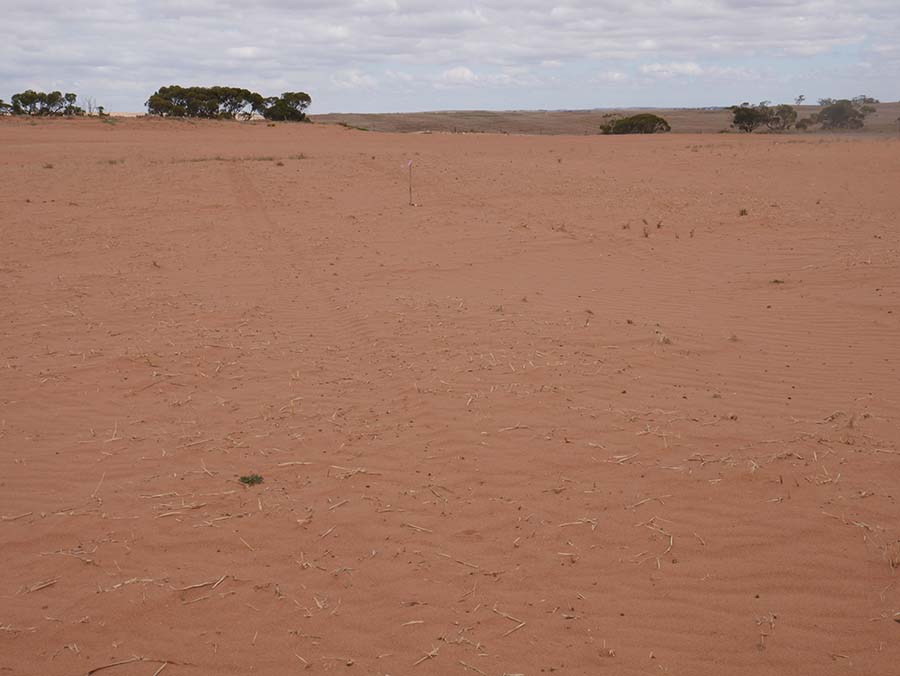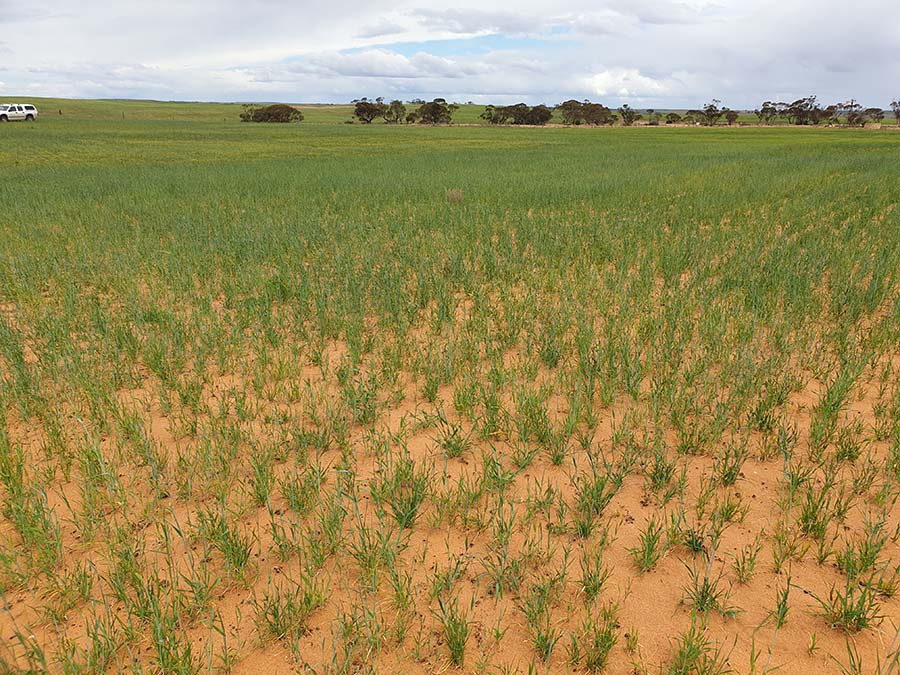Snapshot
Grower: Phil, Yvonne, Aaron and Liz Haby
Location: Walker Flat, South Australia
Farm size: 4,000 Ha
Enterprise: Mixed farming - dryland and irrigated
Growing season rainfall: 270mm annual and 173mm growing season
Soil type: Highly varied - deep sandy rises, loamy sands, sandy loam flats, areas of shallow calcareous stone and heavier clay loams with subsoil constraints
Cropping program: 3,000 Ha cereals and legumes
Seeding system: No-till farming.
Phil, Yvonne, Aaron and Liz Haby farm 4000ha at Walker Flat, with 1000 breeding ewes and they dryland crop approximately 3000ha each year to cereals and legumes. They operate a No-till farming system which is essential for their highly erodible sandy soils and the strong prevailing winds they receive. Complementing their broadacre business, they also produce irrigated potatoes and onions.
Managing blowouts
Farming areas of often steep jumbled sand dunes with a history of erosion had led to the Haby’s purchasing a tractor, scraper and bucket. These equipment purchases have proven economical with approximately 8,000 hours of sand repair completed, in addition to roadway establishment, but they still have a lot to go.
In 2020, a large blowout area quickly got out of control from a heavy traffic strip combined with sheep camping around a trough area, low rainfall and strong winds. In 2021 this site was successfully repaired despite a very late season break and minimal rainfall throughout the year.

Eroded site in March 2021 before levelling. Photo: Supplied.
Despite the risks involved and minimal rainfall received in April, the Haby’s were confident they would still achieve adequate ground cover, even if they needed to resow later. Fortunately, due to soil being essentially fallowed since mid-2020, the first levelling operation brought plenty of moist sand to the surface, assisting crop establishment.
The Haby’s used their 4.5m wide O’Brien Laser Bucket that holds about 13m3 soil or about 25 tonne when full to drag, shift and level the blowout sand area (main image). They pulled it with a 425HP dual-wheeled articulated tractor.
Rehabilitation
The Habys cut through the centre of the blowout area to establish an even grade line, filling in holes, knocking down ridges, and then working each side to level the area.
The area then had 10t/ha of chicken manure spread onto the surface, as it is readily available locally. The site developed a crusty surface following application and assisted in protecting the sand from blowing during the early crop establishment phase, highlighting the value in considering manure spreading on these most vulnerable sites. The surface sand dry aggregation measured a very low 5% in March 2021, but after leveling, spreading manure and seeding, this site showed a safe 35% DA by December that same year.

Composted chicken manure applied to site prior to seeding. Photo: Supplied.
Sowing after levelling
Following the levelling processes, the area was sown to barley. With the dry start, the emerging crop suffered erosion damage and was then cross sown with Vampire cereal rye to maximise soil coverage using a disc seeder.

Cross sown crop growth in early October 2021, with adequate soil coverage despite poor season. Photo: Supplied.
The cereal rye established well after good July rains and continued to grow, producing adequate biomass (above) and providing sufficient soil cover through the following summer with no erosion (below) despite only 130mm GSR. This strategy helped the Haby’s to maintain over 50% soil cover from December 2021 to May 2022 at this site.

December 2021 showing adequate soil cover during summer. Photo: Supplied.
Future rehabilitated area management
The rehabilitated area will not be grazed in the foreseeable future, and the traffic lane has been diverted to a different route. In 2022, the area was resown to another cereal to establish a strong root base in the topsoil, supporting the establishment of a well-anchored standing stubble for the second year in a row. The Haby’s are now confident this paddock will support a productive cropping rotation, including a legume, into the future.
The Haby's experience
To see more on the Haby's wind erosion and levelling experience as it happened.
Watch the Haby's:
Read: Re-levelling blowout areas for effective seeding and harvest.

























































